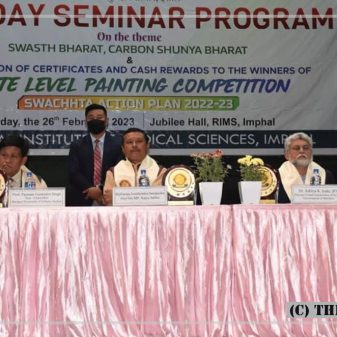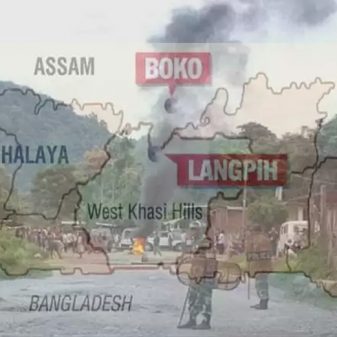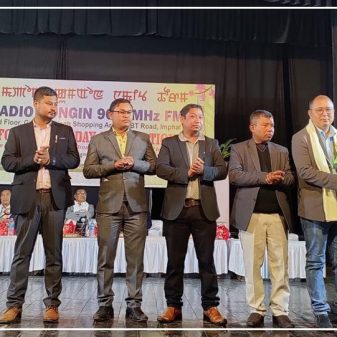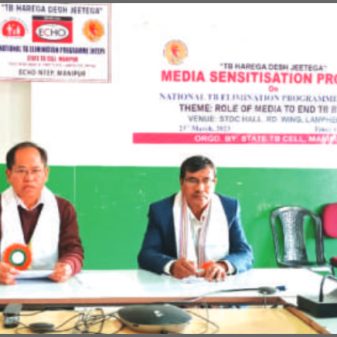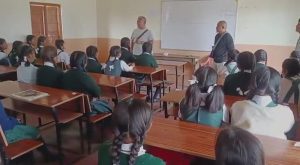
Haritha John
Imphal (Agency): “Do you know what happened to our homes?” anxiously asks 48-yr-old Thombi when she learns that TNM has been to Kangpokpi district where she hails from. With her 18-month-old granddaughter Anjali bundled in a cloth carrier on her back, Thombi prods, “I have heard that you media persons can go across hills.”
It was in a relief camp in Imphal that we met Thombi and her Meitei family in August this year. They had moved there in the first week of May, soon after the houses neighbouring theirs were set on fire.
TNM had been to the places that Thombi named, and found that most Meitei houses were burned down — only a few structures remain.
Meiteis like Thombi who used to live in Kuki-dominated districts like Churachandpur and Kangpokpi have now found shelter in relief camps in the valley. The ordeal is the same for Kukis displaced from Meitei-majority regions. According to the Manipur government, 54,488 displaced people live in 354 relief camps across the state as of July 4. A September 4 report by Outlook Magazine quoted the Indian Doctors for Peace and Development (IDPD) president Arun Mitra as saying that the state now has 334 camps housing an average of 200 people. At all the relief centres that TNM visited, the women wanted to know what had happened to their houses. But most of them realised, there are no more homes to go back to.
In Imphal town, along a half-kilometre stretch that had been inhabited by Kukis, all one can see now are burned down buildings. On TNM’s visit, we saw Meitei volunteers guarding the area, not allowing outsiders to inspect the charred remains of the buildings or take photographs. Leima, a Kuki woman whom we met in a relief camp in Kangpokpi, says she came from a village near Phayeng, which is in Imphal West.
“We had a house and cultivated paddy in the village. When reports of attacks came in, we left home in the clothes we were wearing at the time, without carrying even an extra pair. We don’t even know what state our houses are in. It must all be burnt down,” she says. She is likely right, as Kuki houses were set on fire in the Phayeng region.
In the relief camps, the Meiteis have got a visibly better deal. They have three government-run camps in Imphal that have cardboard cabins for each family. Those living in these camps receive Rs 80 per family every day, and they have the choice to cook separately inside the cabins.
The relief camps in the Kuki regions, however, do not include a single government-run camp. While camps set up in schools run by the Church appear relatively better, the displaced persons are even forced to sleep on mud floors covered with just a tarpaulin in many rural camps that have no proper doors or windows. Their only provisions include lentils, rice, and potatoes.
The Meiteis also have the government’s assurance that their houses will be rebuilt. In fact, rehabilitation measures have begun to some extent, with Chief Minister N Biren Singh handing over temporary shelters situated about 8 km north-east of Imphal, in the third week of August at a function organised in the Sajiwa jail premises. Reportedly, around 400 families can stay in the temporary shelters.
Some of the displaced Meiteis believe that their Kuki neighbours helped insurgent groups enter their neighbourhood and attack their houses. Thombi, who lives in a Meitei camp in Imphal, says, “During our initial days in the relief camp, I used to keep in touch with our Kuki neighbours. But later I began to resent them. I began to think that they may have known the attacks would happen, how else were their properties unaffected.”
In Kangpokpi, on both sides of the road from Saikul to Purum village, at least 50 Metei houses were burned in the attacks. A Kuki resident who used to have a Meitei neighbour tells TNM, “We were close friends, we stayed together. But when the clashes broke out, nothing could be done.”
Leima, who fled her Meitei-dominated village in the valley, says, “We had many friendly Meitei neighbours in Phayeng. But we have no contact with them now.”
More than 60 km from Imphal, we came across a Kuki couple, Sam and Angela, busy searching for valuables among the remains of a torn-down Meitei settlement near the Don Bosco School in Churachandpur. The couple aren’t alone in scouring for valuables among the debris. “The bricks and iron from the torn down buildings were all taken and sold by others soon after the attacks. Sometimes we get money or some precious items from the debris,” Angela says. The debris-filled ground is where a Meitei settlement had stood on either side of the road until three months ago. There is nothing but the debris to indicate that people had lived here until recently.
Recounting the demolitions, a catholic priest from Churachandpur says, “The houses were demolished using excavators and the bricks and iron bars were removed and sold. It was all done out of hatred, and not with an intention to loot. It was the Kukis’ retaliation against the Meitei attacks on their properties.”
In the valley and in the hills of Manipur, the Nagas and Meitei Pangals (Meitei Muslims) fear being caught in the crossfires of the ethnic clashes. Outside their properties, including shops houses, they display posters announcing which community they are from to avoid being set on fire. (Courtesy: The News Minute)

